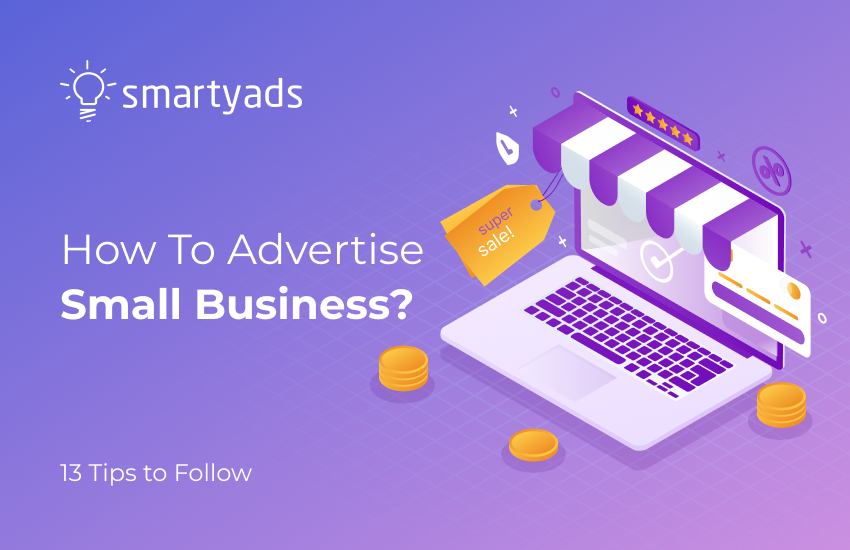A few years ago, Google officially launched a programmatic audio ad platform following the successful example of Spotify, whose income grew to 94% after the implementation of the audio ad format. Even though programmatic audio inventory is still relatively new, it is experiencing stable growth and an obvious rise in popularity. Adoption of AdsWizz by Pandora, a newly-made programmatic audio collaboration of SoundCloud with iHeartRadio and Panoply with TuneIn, is an excellent audio ad example that proves this, too.
Here's how digital audio advertising grows
As the IAB Europe advertising report points out, growth in digital audio continues with momentum, reaching 19.4% growth in 2022. Statista makes predictions for the future and anticipates that by the end of 2028, audio ad spending will account for $13.21bn.
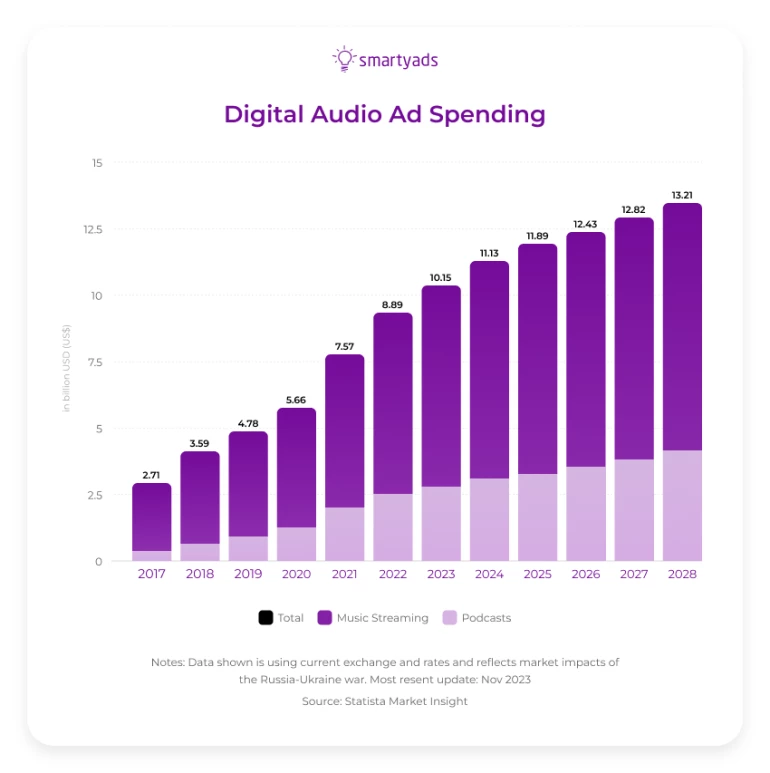
Plus, audio advertising on mobile devices is quickly outrunning desktop due to an abundance of convenient formats for mobile content consumption. A report from Statista reflects that digital audio mobile is a new winner for the US. Thus, digital audio advertising and programmatic audio advertising will be booming soon.
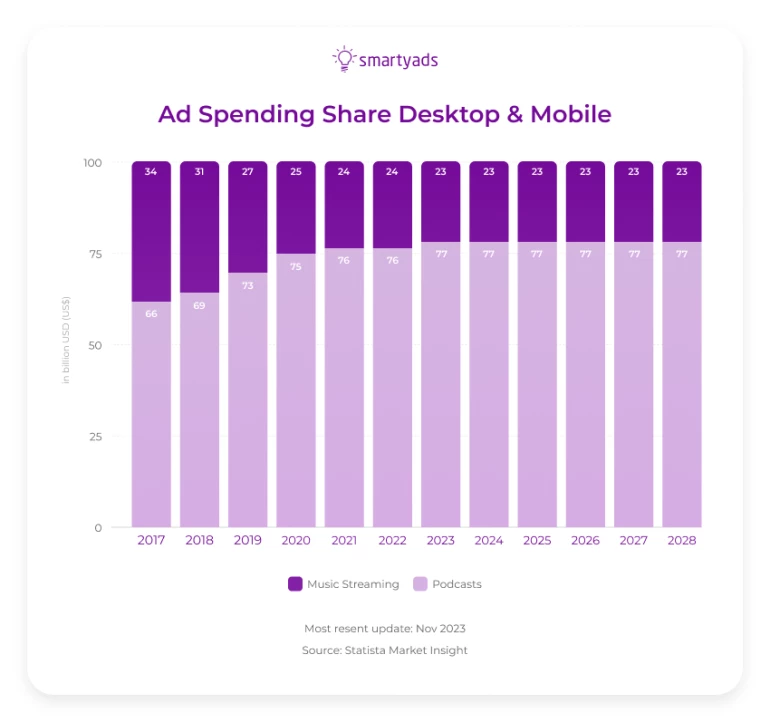
Factors of growth
Thanks to gadgets with a constant connection to the Internet, the penetration of the IoT into our lives, and the global lockdown, consumers are staying online 24/7.
Surprisingly, many people have brought the sport to their lives exactly during the COVID period. They started regularly exercising, running, and maintaining a healthy lifestyle in general. 17% of people exercise more in 2020 than in 2019, and the trend continues. The majority of people prefer to do sports with music or while listening to podcasts.
In such circumstances, programmatic audio advertising holds great potential for those companies that first shifted to the audio format.
What is a programmatic audio ad?
Programmatic audio is a digital advertising format designed for placement in audio content like podcasts, digital radio, and music-streaming services. Like the rest of the programmatic formats, the digital audio advertising segment utilizes algorithmic buying technology in order to automate the process of ad selling and insertion.
Programmatic audio advertising can appear on mobile, desktop, or in-app with equal efficiency. The in-app ecosystem is favorable for the greatest variety of ad formats. For instance, the rewarded ad is designed for mobile game monetization, whereas simple audio or audio & banner will suit any other app type: podcast app, music streaming, news app, etc.
How does programmatic audio advertising work?
Programmatic audio ads infrastructure wasn't fully ready for programmatic until IAB developed the Digital Audio Ad Serving Template that's used by the majority of audio partners. A few years ago, IAB updated the VAST protocol in order to address the existing gaps in creative rendering.
The VAST protocol defines the placement procedure for linear audio ads (appear before, after, or in the middle of audio content consumption). As a rule, they accompany the following formats:
Companion ads
Static banners containing logo and CTA that appear while users are streaming music. Available for clicking upon while the audio ad delivery is in progress.
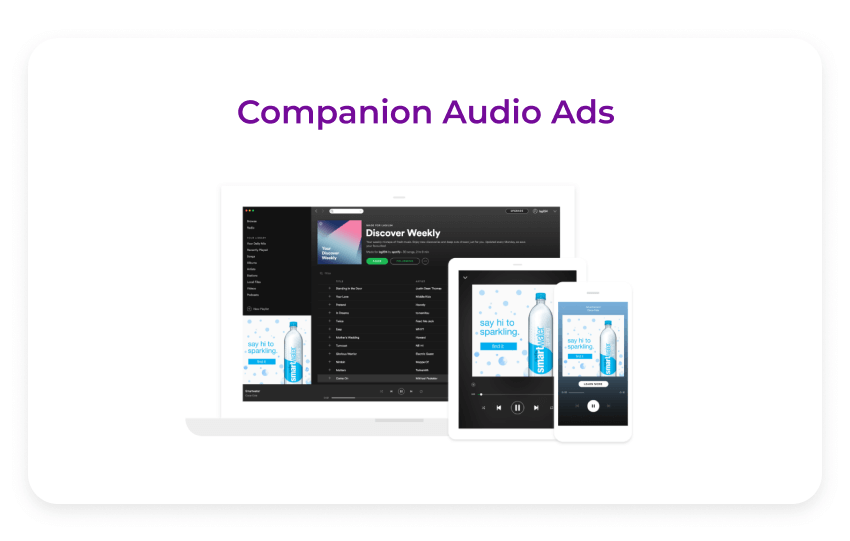
Ad placements for 1 or more audio tracks within audio content.
Skippable Ad
Pre-roll and mid-roll tracks in the audio file feature different benefits.
Rewarded Ad
15-60 sec-long in-game audio ad track that provides an in-game bonus to the user upon audio completion.
Podcast ads
The commercial digital audio ads are placed within podcasts (on-demand Internet radio talks).
You can serve an ad unit within songs in the playlists, as pre-roll or mid-rolls within podcasts, within radio ad breaks, or in mobile games.
Interactivity defines programmatic audio ads trends
Audio formats are now useful not only for the purposes of raising brand awareness but also for drawing attention to targeted actions.
Interactive elements of programmatic audio ads and visual advertising technology provide user engagement. The most popular are rewarded audios and companion ad units placed on the device screen at the time when the audio recording is playing.
What are companion ads and their benefits?
Take a look at the static banner on Spotify. In the free version, they're streamed to users at an interval of every 30 min. Sometimes, they stay on the screen after the audio ends to let the user interact with an ad later. The format doesn't require user action to be triggered. The listener is streaming music or online radio without interruption.
What are podcast advertising and its benefits?
Edison's research has revealed that 42 million US citizens normally listen to podcasts on a weekly basis. This audio space (on-demand Internet radio talks) is wrapped around streaming audio across certain topics (food, entertainment, sports, fashion, lifestyle, etc.), which can be used for podcast advertising purposes.
Podcast directories usually contain links using which brands can drive traffic to their websites.
What are rewarded audios and their benefits?
Reward advertising amplifies the brand's message, especially in specific genres of apps like games. Extra lives, coins, daily rewards, and closed content are incentives in exchange for listening to ad content.
This format is not restricted by ad blockers. It is characterized by a 100% completion rate and publishers' CPM that, on average, reaches $2-$30. Since the rewarded ad doesn't distract users from the game or affect in-game progress, it is considered less intrusive than an average visual ad. All of these factors translate into higher user retention and satisfaction.
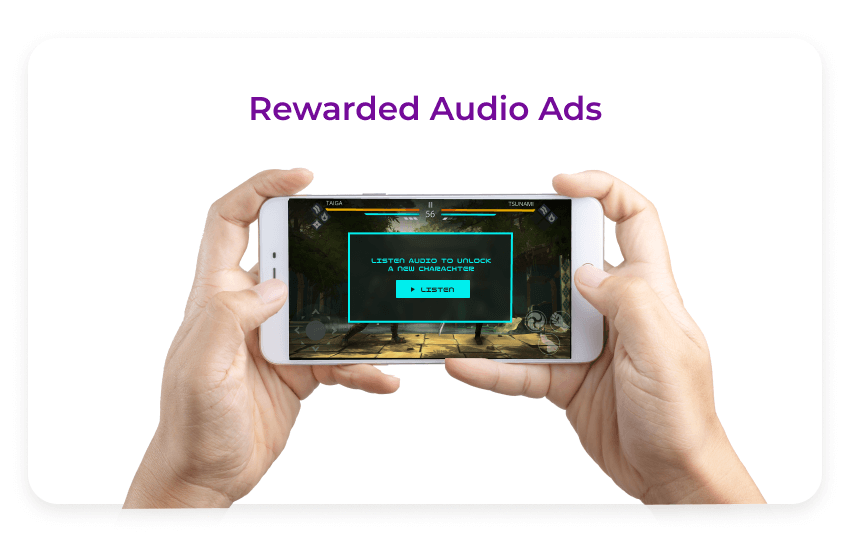
Another great way to use an audio creative appears to be geofencing. This geolocation technology is syncing audio unit delivery to brick-and-mortar shops. It uses GPS settings on the cell phone to serve users' audio ads right on the spot in order to encourage shop visits.
Mobile publishers can implement programmatic audio buying via SDK specifically adapted to render audio ad formats. Because such an SDK utilizes the Application Programming Interface (API), it can be connected to all kinds of SSP. The API will be responsible for drawing demand partners to the app who want to bid for certain digital audio advertising slots in particular app categories. Then, API will be doing the rest of the work: pairing ads from the server to mobile SDKs for further rendering.
Benefits of programmatic audio | |
Benefits for publishers | Benefits for advertisers |
Audio format is not visible to ad blockers so publishers will not lose revenues on every restricted impression. | No competition for user attention due to format specifics. Audios are served one at a time. Unlike visual creatives, ad tracks aren’t placed next to each other. |
One of the highest levels of CPM - around $2-$30 | Ability to reach the user outdoors: during morning strolls, and while driving. For rewarded in-app audios: after listening, the user gets an incentive that creates positive ad perception, increases engagement and loyalty. |
Unlike other formats, audio doesn’t depend on size, screen, or picture resolution. The ad insertion can be server-side and client-side (on standard player technologies). The rendering is the same as for videos but without visual components included. | Possibility to serve the ad to the users even if they are not looking at the screen at the moment. |
Smooth creative rendering. No glitches. Seamless user experience. | Affluent, tech-savvy, and good-quality audiences (mostly millennials and gen Z). |
Easily fitted for the mobile experience: the majority of audio streaming is happening via mobile devices. | Audio programmatic formats are served in the cleanest low-risk environment guaranteed by server-side ad insertion and traffic quality filters. |
Easy installation. The integration process can be as easy as HTML copy+paste installation for radio. Mobile publishers/developers need a mobile audio SDK, the implementation of which is the same as any other SDK. | Listening is less dependent on cookies and requires a people-based audio approach which is also very important in regard to GDPR. |
Non-intrusive, non-irritating and doesn’t distract users from the game experience. This positively affects the user retention rate in apps. | |
A few challenges that linger
As most challenges have gone to the past, rendering digital audio content became possible according to both DAAST and VAST standards. The latest upgrades of IAB enabled programmatic platforms to transact the videos using a single framework. As a result, more digital audio inventory becomes available at open marketplaces. Still, some obstacles will find their resolution as soon as technology hits mass adoption:
Insufficient demand and supply
Supply still outweighs demand, meaning there may be remnants in programmatic audio slots, or the price may be lower than expected. In such circumstances, until the market grows enough, non-programmatic or programmatic direct deals for publishers will make more sense than RTB.
Technology incompatibility
It's worth remembering that not all programmatic platforms are designed to support audio formats. Those with such functionality should feature separate SDKs for digital audio formats or enable API connection.
What's the future like for programmatic audio advertising?
First, we should provide an answer to the question — how does programmatic audio advertising work? The general principle of programmatic advertising is based on precise audience targeting.
Precise targeting
If previously media buyers had to target specific genres and niches on radio, with programmatic advertising (automated systems), audience targeting parameters could be extended to geo, age, income level, type of device, OS of the gadget, and so on.
Thanks to this, targeted ads reach audiences most likely to make a purchase. As a result, the ad recall increases, and the online advertising campaign budget typically gets saved (since targeted ads are not broadcasted to podcast listeners who fall out of selected targeting criteria).
Advertisers can strategically target digital audiences by geo, time of the day (and other parameters that traditional broadcast parameters allow).
More efficiency
Today, online audio advertising can do everything that traditional radio ads can. At the same time, due to placement in an interactive environment, programmatic audio ads not only attract digital audio listeners but also immediately convert them into customers with a link in the banner that accompanies the audio (e.g., on digital radio).
In connection with this and the growing number of audio streaming services, the volume of audio placements will soon be comparable to traditional radio advertising. It is also expected that the capacities of digital audio ads will be extended in the future thanks to the platforms, voice assistants, and bots. If this happens, users will be able to interact with an audio ad unit using their own voice commands.
How to make it work?
Activating programmatic audio ads is just as simple as video ads or native ads if you use an advertising platform like SmartyAds DSP. Here's how to reach premium digital audiences with SmartyAds:
Create a campaign
Register at SmartyAds DSP, and go to the dashboard and the campaigns section. The first step will be choosing a campaign type — select "Audio".
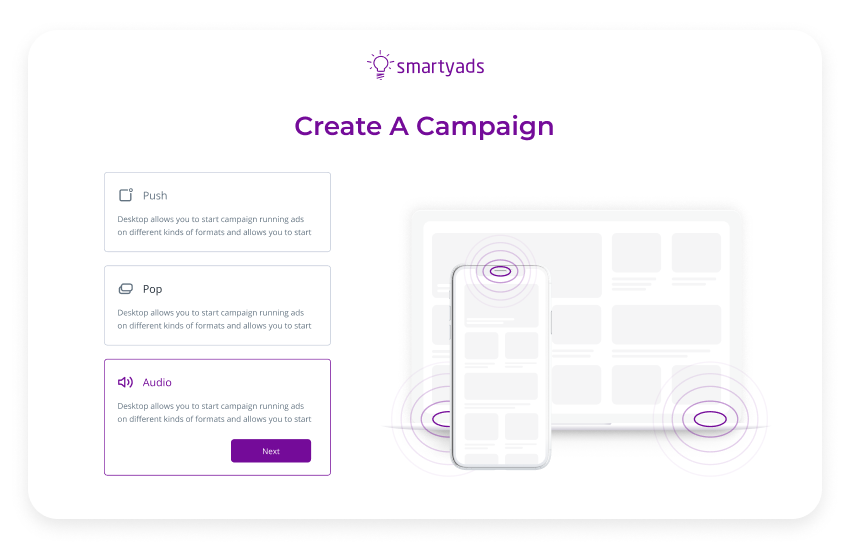
Upload your audio creative
Upload your audio creative in the campaign settings.
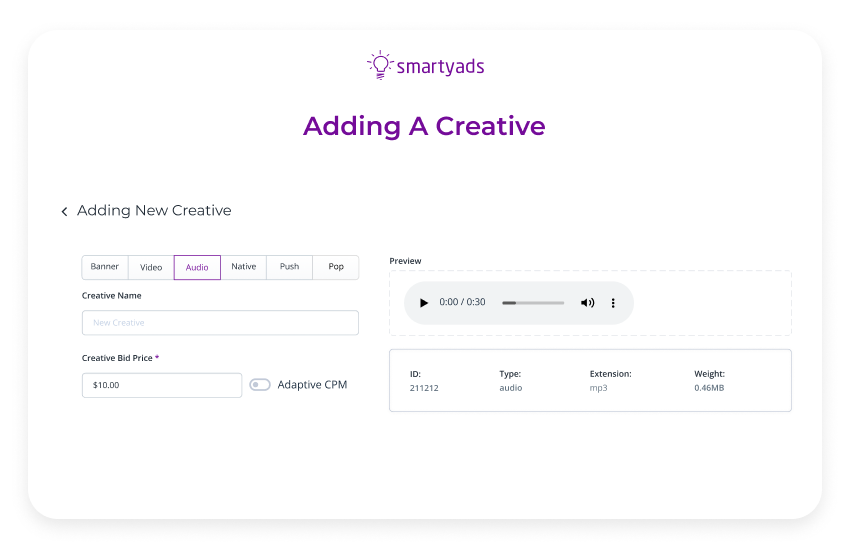
Activate your audio ad campaign
After this, you can set up the parameters of your digital advertising campaign and activate it.
Benefits you get from running programmatic audio ads with SmartyAds
First of all, the campaign execution process gets automated and more efficient. Here is the list of benefits that you can receive while advertising on SmartyAds DSP:
Seamless user experience
Ads will be delivered one by one, which guarantees the direct interaction of the audio ad with the target audience. Thus, digital audio listeners stay focused only on your ad and don't get distracted by other ads (as often happens with image formats).
No ad blockers
Digital radio space was never affected by ad-blocking tools. Music streaming services instead offer special ad-free subscriptions. However, the majority of music and podcast listeners stream ad-enabled content, which is not interrupted by any ad blockers. Thus, a media buyer can reach a valuable audience with no risk of wasted budget.
Highly-targeted experience
The ad-buying workflow in audio programmatic is pretty similar to other formats. On DSP, advertisers choose suitable targeting criteria as they do for banner and other types of campaigns.
Omnichannel campaigns
On SmartyAds DSP, advertisers can run cross-device campaigns on other digital media channels and with other formats as well. For example, the platform supports connected TV advertising, serving banners, video ads, native ads, and even DOOH.
Summing it up
SmartyAds works closely with mobile developers and technology partners, such as AudioMob, to ensure that our rewarded and podcast audio ads arrive to the listener naturally, in a non-intrusive manner. With our solutions, publishers can tap into the world of increased revenue opportunities that raise the publisher's CPM to $2-$30 and higher. Advertisers, in turn, can add programmatic audio ads to their overall campaign mix, implement premium programmatic strategies, and gain more views, sales, and conversions.
Implement audio programmatic into your marketing strategy with SmartyAds. Register on SmartyAds DSP to get started!
FAQ
A programmatic audio ad is a dynamically placed digital audio advertisement, typically utilizing real-time bidding and automated technology. These ads are personalized based on user behavior, demographics, and context, delivering targeted messages to the right audience across various audio platforms, such as streaming services and podcasts.
Programmatic audio ads offer precise targeting, reaching specific audiences based on behavior and demographics. They provide real-time analytics, allowing advertisers to measure campaign effectiveness. With automated placement, these ads enhance efficiency and cost-effectiveness, ensuring optimal engagement and impact on audio platforms like streaming services and podcasts.
Programmatic audio ads face challenges such as ad fraud, where illegitimate impressions affect campaign performance. Limited standardization in ad formats and measurement metrics poses difficulties in consistent evaluation. Ad-blocking technology also impacts reach, hindering advertisers from seamlessly connecting with their intended audience in the programmatic audio landscape.




